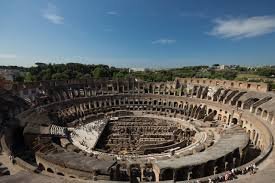The Colosseum, known as the Flavian Amphitheatre in ancient times, stands as one of the most iconic symbols of Rome’s imperial power and architectural brilliance. This colossal structure, capable of seating over 50,000 spectators, was the heart of Roman entertainment, hosting gladiatorial combats, wild beast hunts, and even mock naval battles. But beyond its well-known history, the Colosseum holds secrets, forgotten tales, and engineering marvels that continue to astonish historians and visitors alike.
The Grand Vision of Emperor Vespasian
The Colosseum’s construction began under Emperor Vespasian in 70 AD, a strategic move to gain public favor after the turbulent reign of Nero. Built on the site of Nero’s extravagant Domus Aurea (Golden House), the amphitheater was a symbol of the Flavian dynasty’s commitment to the people. Vespasian’s son, Titus, inaugurated the Colosseum in 80 AD with 100 days of games, where thousands of gladiators and animals perished in spectacles of blood and valor.
A Marvel of Ancient Engineering
The Colosseum’s elliptical design, standing 157 feet tall, was a feat of Roman engineering. Its tiered seating ensured clear views for all, from senators to commoners. Beneath the wooden arena floor lay a labyrinth of tunnels and chambers called the hypogeum, where gladiators and beasts awaited their fate. Trapdoors and elevators powered by pulley systems allowed dramatic entrances, creating theatrical effects that awed audiences. Remarkably, the Colosseum’s outer walls were originally clad in gleaming travertine marble, a sight far more magnificent than its current weather-worn facade.
Gladiators: Heroes and Slaves of the Arena
Gladiators were both celebrities and slaves, trained in brutal combat schools like Ludus Magnus near the Colosseum. Contrary to popular belief, not all fights ended in death—skilled fighters were valuable investments. Some, like Spartacus, became legends, leading revolts that shook Rome. Women also fought as gladiators, though Emperor Septimius Severus later banned them. The crowd’s whims decided a fallen warrior’s fate—thumbs up meant mercy, while thumbs down signaled death.

The Colosseum Darkest Spectacles
Beyond gladiator battles, the Colosseum hosted venationes (beast hunts), where exotic animals like lions, elephants, and crocodiles were slaughtered in staged hunts. Some events recreated mythical scenes, such as Orpheus charming beasts before being torn apart. The most shocking were naumachiae—mock naval battles flooding the arena with water. Historians debate how this was achieved, but evidence suggests a complex aqueduct system diverted water from nearby sources.
Underground Secrets of The Colosseum
The hypogeum, rediscovered in the 19th century, was the Colosseum’s backstage. Here, slaves operated elevators to lift animals and fighters into the arena. Archaeologists found graffiti by gladiators, some scribbling prayers or boasts. One chilling discovery was the remains of a dwarf gladiator, proving Rome’s appetite for bizarre entertainment. The hypogeum’s design was so advanced that modern stadiums, like Las Vegas’s Caesars Palace, draw inspiration from it.
The Colosseum Role in Early Christianity
For centuries, Christians believed the Colosseum was a site of martyrdom, though evidence is scarce. Pope Benedict XIV consecrated it in the 18th century, erecting a cross to honor supposed Christian victims. Today, the Pope leads Good Friday processions here, blending ancient history with religious reverence.
From Ruin to Icon: The Colosseum Survival
Earthquakes and stone-robbers left the Colosseum in ruins by the Middle Ages. It became a quarry for St. Peter’s Basilica and other buildings. Yet, its skeleton endured, thanks to preservation efforts starting in the 1800s. Benito Mussolini staged propaganda events here, linking fascist Italy to Rome’s imperial past.
Modern Mysteries and Pop Culture Legacy
The Colosseum remains a cultural icon, featured in films like Gladiator. At night, some claim to hear ghostly roars of long-dead crowds. Restoration projects continue, including plans to rebuild the arena floor for events. UNESCO declared it a World Heritage Site, ensuring its legacy lives on.
Go to main page


